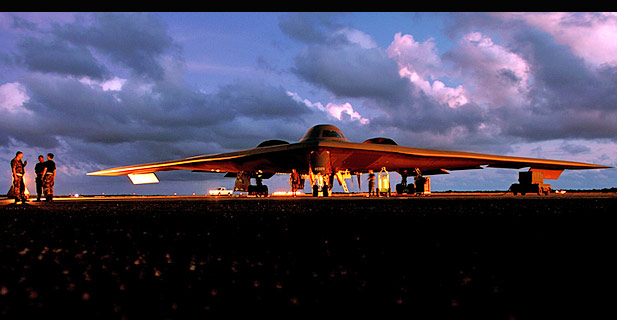
Air Force wants subsonic bomber by 2018

The Air Force may trade building a faster bomber in favor of building a bomber faster — even if it means lowering technological expectations for now.
Expectations seem to have been dialed down from a supersonic, super-stealthy long-range bomber to a manned, subsonic aircraft with a range of 2,500 nautical miles. Sources say the service plans to buy only about 100 of the stop-gap planes while exploring other options for future bombers.
As recently as last year, the Air Force planned a new bomber program between 2025 and 2037. But the Pentagon’s 2006 Quadrennial Defense Review said the need was more urgent.
So service leaders developed a three-pronged approach: modernize existing bombers, use today’s technology to put a new long-range strike plane in the air by 2018, and seek new technology for yet another new aircraft for service no later than 2035.
The 2018 deadline means major requirements decisions will have to be made in 2009, with a contract awarded around 2011.
“To build by 2018, the Air Force must minimize technological risk. That is really key,” said Rebecca Grant, president of IRIS Independent Research in Washington and author of the Air Force Association special report “Return of the Bomber: The Future of long-range Strike.”
Grant said the service will have to go with a mature design, a survivable shape and advanced avionics.
She also recommended using an engine with a proven track record, at least initially; a newer engine could be retrofitted later, she said.
A bomber that could arrive and depart at supersonic speed to strike heavily defended targets would provide a strategic advantage, said Loren Thompson, an analyst with the Lexington Group.
“Speed gets you the element of surprise. It puts you in control of the situation,” Thompson said. “In some circumstances, it’s essential. In some cases, it’s more important to be supersonic than it is to be stealthy.”
However, senior Air Force leaders said that the heat signature of a supersonic aircraft negates that advantage. A barely subsonic aircraft that isn’t attracting attention with its heat signature is more practical at this point, they said.
They also note that such speed requires a large amount of fuel.
An aircraft that can almost reach Mach 1 is high subsonic, which is enough speed for an interim bomber and superior to an aging fleet made up of supersonic 1980s-era B-1s, a small number of B-2s and B-52s that have been in service for more than 40 years.
As the Cold War thawed, the planned purchase of B-2 bombers was whittled from more than 130 to fewer than 100 and finally to 21, with production ending six years early in 1997. The end of the B-2 left the U.S. without a bomber in production or development for the first time since 1917, Grant wrote.
From the very beginning, the late-1980s cockpit technology in the B-2 caused problems for aviators, and there were complaints of not making use of supersonic technology that was used in the B-1.
But those problems, and others, have since been solved, Grant said. Since the close of the B-2 program, the technology has been pushed ahead by the F-22 Raptor and the F-35 Lightning II fighter programs.
Source : By Gayle S. Putrich - Staff writer— AirForceTmes --
(www.airforcetimes.com)
Posted : May 18, 2007
Photo : Aircraft mechanics prepare a B-2 Spirit bomber before a morning mission at Andersen Air Force Base, Guam. The Air Force plans to buy about 100 subsonic bombers by 2018 as a stop-gap measure until a supersonic aircraft can be developed. [ AirForceTmes photo]
(20.05.2007)
|